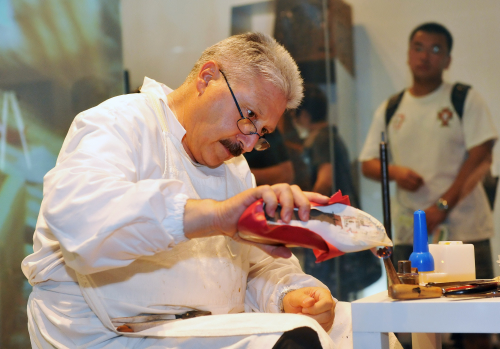Handmade charm
At a time when our lives are dominated by assembly-line products, handmade crafts are increasingly rare, as are the skillful craftsmen who make them. But the Expo gives visitors a chance to watch artisans practice their craft, making everything from water paintings to shoes to sand art.
Fashion dreams
Location: Italy Pavilion, Zone C of the Expo Park
If you are a fan of fashion, the glass-walled workshop of the Italy Pavilion is definitely a place you should not miss. When our reporter visited the workshop, Italian shoemakers were demonstrating the process of making Ferragamo shoes – which many women in the world dream of owning. It takes five days and at least 200 steps to finish a pair. Although the shoemakers at the pavilion only demonstrate seven of the most important steps in this process, their demonstration vividly showcases the superb skill of Italian shoemakers and the Italian commitment to high quality.
| An Italian craftsman makes Salvatore Ferragamo shoes at the Italy Pavilion. |
Spectacular sands
Location: Jordan Pavilion, Zone A of the Expo Park
What can a bottle, a funnel and some sand of different colors make? You will find the answer at the Jordan Pavilion. Sand art originated in the city of Petra in Jordan during the early 20th century. Today there are very few sand artists who have attained the level of mastery of artists from Jordan.
For this reason, the pavilion's stunning demonstration of bottled sand art never fails to attract a large, enthusiastic crowd. Unlike ordinary painters, artists from Jordan use funnels and iron wires to "paint" their pictures. The sand, specially transported from Jordan to Shanghai, is mixed with powdered paint and food coloring to create different hues. Jordanian artists then pour the sand into a variety of bottles in order to form designs and colorful layers. For those new to the art it is a painstaking process, but veteran artists at the pavilion can create a picturesque, fist-sized desert painting in just a few minutes.
| The Jordan Pavilion's stunning demonstration of bottled sand art never fails to attract an enthusiastic crowd. |
 0
0 









Go to Forum >>0 Comments